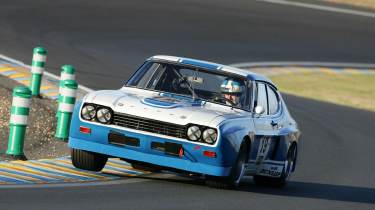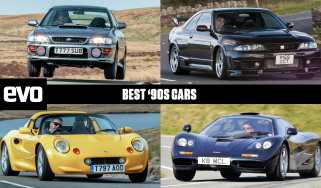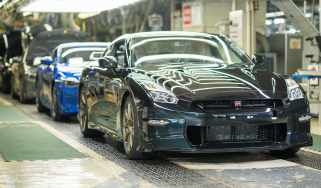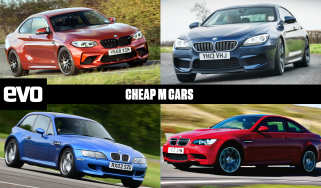Le Mans Classic: Blast from the past
For self-confessed Capri-nut John Barker a chance to drive a race-spec RS2600 in the Le Mans Classic was a dream come true
Even before it has fully unfolded, I know this is going to be one of the best moments of the weekend. It’s early, around 7am, and the thin light lends the scene a marvellous clarity as I turn for the kerb at Mulsanne Corner. The Capri rolls then settles, and the moment it does I’m back on the throttle. Its wide hips sashay towards the rumble strip on the exit and then we’re straight and hooked up. The tail of the famous Gösser Beer BMW CSL is closer now, maybe just four car lengths away.
Capri versus CSL, Ford versus BMW. In the early ’70s this battle was the highlight of the European Touring Car Championship, and this morning a small skirmish is being recreated at the 2008 Le Mans Classic.
The Capri’s unsilenced, unfiltered V6 howls to a glorious 7600rpm in second gear, then third, then fourth, and we’re gathering big speed as we head through the cool shade of the trees down towards Indianapolis. In the screen the winged rump of the CSL remains exactly the same size until I slot fifth before the second kink. Now the gap is closing, and here’s the kink. I steer slightly more right than on previous laps and on the exit, at around 150mph, I’m up the inside and driving easily past. Ker-ching! Back of the net! Chalk one up for Ford.
Boy, am I into this. It’s no secret that I’m a big fan of the Capri, and the ultimate version is this, the wide-arched RS2600 racer. I never imagined I’d get to drive one, let alone race one, and on the full eight-mile Le Mans circuit, too.
It’s a dream come true, but almost as soon as I’d accepted the offer, I started to worry. A few people said the Capri would be very heavy to drive, what with monster slicks and no power steering. Then there was the venue: being based largely on public roads, the long circuit exists once a year for the 24-hour race and once every other year for Le Mans Classic. So the chances of driving it beforehand were nil. And worry turned to quiet but rippling panic when I discovered that one of my teammates would be Jean-Louis Schlesser, former F1 driver, multiple sports car champion and Dakar winner (twice in his own, Ford-powered car).
I gave up smoking, bought my first pair of running shoes and discovered that I have a local gym. I’m deadly serious. I also got Catchpole to set up the office PlayStation with La Sarthe and the nearest thing to an RS2600 I could find, which was a new Mustang. While I didn’t get pixel-perfect I did gain a good understanding of which corner in the Porsche Curves I was going to fall off at – right-left-left-right-lef…CRASH!
There’d be no reset button in the Capri. I got to test it, briefly, just a week before the race, at a little known track in eastern France. With the backing of Ford Europe, Ford France had secured the use of both the Capri and a 1923 French-built Model T for the 2008 Classic. The Capri’s best finish at La Sarthe was a flattering 10th overall in 1972, and this car has been recreated from the lone Capri that raced in ’74 under the ‘Shark Team’ banner. It lasted until the 16th hour, then the clutch gave up.
‘We have tried to retain as much of the original car as possible,’ says Yvan Mahé, the car’s owner and boss of Equipe Europe. A glance inside reveals that back then lightness was clearly more important than safety – the roll-cage is little more than a sparse collection of modest-diameter tubes. Then it fires up and my eardrums almost explode. ‘Sounds great,’ I say to Stéphane Cesareo, PR boss of Ford France and prime mover behind the company’s 2008 Le Mans Classic effort. ‘Yes. It showed 394bhp on the dyno,’ he replies. So, about 900kg and near 400bhp. Nice.
Schlesser, who’s 60 this year, isn’t here today – he’s resting a shoulder he broke three months ago when he was thrown from his trials bike – but my other teammate, Sport Auto writer Yves Bey-Rozet, is. He and I get the same quietly insistent chat from Yvan: treat the gearbox very gently, going up and down. When I get behind the wheel I wonder why I’ve been to the gym – the Capri feels as light as an Elise on its grooved Michelin TB15s, even though the rears are 11.5in wide. It feels very powerful but its chassis feels very soft. Between batches of laps, Yvan asks me to try harder to get the shifts ‘just so’.
LESS THAN A WEEK later, my brother Chris and I share the drive down to Le Mans in a Shelby Mustang – life imitating (pixel) art or what? A day after that, along with the other five Ecurie Ford France drivers, including Octane editor Robert Coucher, who is one of the Model T drivers, I pilot a Focus ST around the track for my first real lap of Le Mans. I’m expecting a brisk lap, but just as I’m marvelling that Mulsanne really is a public road – early on there’s a fully formed roundabout cut off by three-layer Armco – Schlesser’s Focus ST comes bollocking past, followed by another. I join in and I’m very happy to discover how faithful the PlayStation rendering is.
Next time I see the track is an hour later, through the windscreen of the Capri in qualifying. Here goes. Don’t stall, remember to turn off the high pressure fuel pump at the pit exit and nice and easy with the gearshift. As Yves had described, there’s a lot of wander down Mulsanne and a few hundred yards before the first chicane the engine has found the 7000rpm limiter that it’s running for qualifying. The car feels softly set up too; you have to give it time to settle before getting back on the power, and the wander is even more of a concern on the run down to Indianapolis, where you’re looking for precision through the fast kinks.
On the second lap I’ve taken a chunk out of all the braking distances and it feels better overall, yet still quite relaxed because I’m concentrating on the gearshift as much as anything. I’m looking forward to a third lap but the flags are out after the Dunlop Bridge, denoting the end of the session, and we’re shepherded off the track. Our best lap is a 5.07, ahead of the other Capris, meaning that Schlesser will start the race just inside the top 40 of the 60-odd cars in plateau six.
There are six plateaus (classes), each of which gets three races of just over 40 minutes spread evenly over the 24 hours, plateau one starting things off at 4pm on Saturday and plateau six finishing at 4pm on Sunday. In the Capri we each get to start and finish a race, Jean-Louis starting race one and finishing race three. Yves partners him in race one and starts race two, while I finish race two and start race three.
I hang around for night practice at 1.30am but it doesn’t go well. Yves brings the car in having done most of the out lap in fifth gear – a bolt has fallen out at the base of the lever and it’s pivoting uselessly. Better now than in the race tomorrow, though. We get back to the hotel at 3.00am.
SATURDAY SEEMS TO go on forever. I’m not racing until around 7am on Sunday, but there’s lunch with John Fleming, boss of Ford Europe, and the start of the racing, too. The first four classes have the drivers running across the track in, well, classic Le Mans fashion, though after this evocative but faux start the cars are sorted back into grid order on the Mulsanne Straight and brought round for the real rolling start.
The spectacle and the sounds get better with each successive generation. Each plateau has its legends and an oddity or two – Bugatti Type 37s and the Model T in plateau one, for instance; Aston Martin DBR1s and a two-stroke Saab 93 in plateau three. There are nine or ten Le Mans-winning drivers here, too, and plenty of other famous faces. I keep seeing the petit René Arnoux (who’s racing a Chevron in plateau six), while one of the BMW M1s is being co-driven by the French PM, Francois Fillon.
I’m starting to feel pretty tired by 10pm but there’s no way I’m missing the Capri’s first race. It’s properly dark when the cars roar past for the first time, and after three dozen low-slung sports cars the Capri looks tall and incongruous but sounds raw and powerful. On lap two Schlesser is up to 30th! Impressive stuff. He gains another place and posts a lap of 4.49 on the next tour. A couple of laps later he pits for the driver change and members of the team, including Bey-Rozet, end up hoofing it up the pit lane after him. Shortly afterwards they wander back – Schlesser decided there was too much traffic there already and elected to do another lap.
On the next lap the driver swap happens. Bey-Rozet heads off into the dark while Schlesser stands in the pit lane lit by three film crews, giving interviews. Later I ask him how it was. ‘I passed a sports car under braking,’ he smiles. Did you pass eight cars on the opening lap? ‘It’s possible,’ he grins. When Bey-Rozet brings the RS2600 home he looks flushed and very happy. ‘What an incredible engine,’ he says. ‘It pulls to 7600rpm now.’ The Capri is classified 23rd. Incredible. Now it’s time for sleep.
THE ALARM CLOCK goes off at 4.45am, what feels like two minutes after my head hit the pillow. It’s dark. It’s Le Mans. At the track, standing outside the hospitality suite overlooking the curve up to the Dunlop Bridge, the sun is just creeping up, giving the scene a soft orange glow. The stands are virtually empty, which is a pity because out of the quiet comes a furious cacophony announcing the imminent arrival of a whole bunch of what, for me, are the most inspiring race cars here this weekend: Ford GT40s, Lola T70s and Porsche 917s. This alone was worth getting up for.
Yves starts the race and is holding a spot in the low 20s with ease. After four laps, the Capri is coming down the busy pit lane. Then I’m running – he’s pulled up half a dozen garages early, having seen someone in a blue and white helmet similar to mine. No matter, we’re there quickly and there’s a minute’s wait before I can get going; the minimum time from pit-in to pit-out is 90sec. ‘It’s very loose,’ says Yves, ‘especially under braking.’
Is it ever. Hit the middle pedal and it takes attitude in a straight line, and it feels really edgy hauling down and sweeping gently right into Mulsanne Corner, but it’s very forgiving – it never gets really out of shape, just strikes a pose and then holds it. We’re also getting to the braking points with more speed now that the limiter has been raised, seeing 7700rpm (almost 160mph) before the first chicane and around 7500 before Mulsanne Corner and down to Indianapolis.
I have the track to myself for a couple of laps before coming across a sports racer that’s suffering an intermittent problem. It’s as we are passing and re-passing each other that the Gösser Beer CSL heaves into view. Have it. I’m guessing this is the last lap, so when I catch a pale yellow 911 going into the Ford Chicanes at the end of the lap, there’s only one thing that’s going to happen. I can see the chequered flag in the distance as I dive up the inside into the last corner but one. Another low-20s finish is in the bag.
SOMEONE ASKS ME MY strategy for the start of the last race and I tell them it’s the same as for the previous race: don’t f*** up.
It’s in the holding area, with a Ferrari 512BB LM on either side, that I get around to asking why we are on treaded Michelin TB15s and everyone else is on slicks. Yves translates the reply of Fred Bouillon, the mechanic who has looked after the Capri all weekend, and it seems to be for two reasons: first, that it might rain, and second that slicks would put more stress on components like wheel bearings. Also, I tell myself unhelpfully, the 35-year-old shell may once have been acid-dipped to paper thickness to save weight…
Eventually we’re released and make a slow lap behind the pace car. Everyone around me is weaving to warm up their slicks. No point for me. Besides, I’m concerned that a strong vibration is shimmying the steering wheel. I was the last one to drive the car and it felt fine then, so it’ll be fine, I tell myself, and concentrate on warming the brakes up and staying as close as possible to the car in front as we near the start straight.
And we’re off! The Capri isn’t great in the slow corners so I’ve just about held station with the pack in front when we get to Tertre Rouge. I’m expecting the cars in front to stretch away now but instead it’s like they’re reversing towards me! I find myself weaving in and out, picking up a place here and there. The Capri feels looser than ever and the fat Michelins at the back seem to have a bit less grip too, but I soon get right in the groove and settle down to a deeply satisfying drive that seems to get the best out of the car. The low-slung, 7.4-litre Corvette that started in front yo-yos along in the rear-view mirror, gaining and losing yardage, and the Gösser Beer CSL looms on my ‘in’ lap, but only a white sports car comes by before I pit and hand over to Jean-Louis.
I join the Ecurie Ford France team on the pit wall for the final laps and find them making rain dances. Since race one we have been lying second on the Index of Performance, a sort of handicap system designed to give all cars an equal chance of victory. To win it, what we need right now is for the dark clouds above to deliver a deluge, but all we see are a few drops. However, at the end of the race, which sees us clock up another low-20s finish, Jean-Louis tells us the track was proper wet on the Mulsanne side.
It’s only later, when my brother Chris and I drop in to get the results of the third race, that we discover that the Ecurie Ford France Capri has won the Index of Performance for class six. And then I recall seeing a black Porsche 935 limping in with a wobbly right front and a missing wing. That was the car that was leading the Index, so maybe the rain dances really did work…
It’s great to win a big pot but even better to finish 17th overall in plateau six. However, the best moment for me is when I catch up with big Yvan in the paddock. I immediately apologise for a couple of less-than-perfect gearshifts, but he says, ‘I watched you through the Porsche Curves. Magnificent. It’s such a good-looking car.’
It certainly is, and I’ve had the time of my life driving this Capri. It really doesn’t get much better than this.
Many thanks to Stéphane Cesareo and the Ford France team, Paul Harrington and the Ford Europe team, and Yvan Mahé, Fred Bouillon and the Equipe Europe team
The never ending story
You’ll be unsurprised to learn that my own Capri hasn’t seen much action this year. I have a theory that it is surrounded by a bubble that makes time pass much more slowly. Currently trapped inside it is the normally brisk and efficient Nathan Bovingdon at Paragon in Northampton. Six months ago Nathan replaced the Capri’s track-rod ends and MOT’d it – all done pretty pronto – but driving home the engine made some ominously clanky noises.
I reckoned it had run at least one bearing, but there was no way I could leave the Capri in the dodgy area where it was, so I drove it the couple of miles back to the office. I know, I know…
Nathan collected the car a few days later and took on the job of rebuilding the V8. Half a year later he and the rest of the gang at Paragon have finally tired of pushing the Capri in and out of the workshop; they have asked me to bring money and take it away. The normal sign-off is ‘stay tuned’, but I wouldn’t want you to waste your time. Expect another update eventually.




